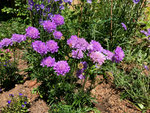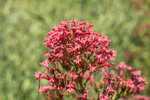
Jill Severn
Photo by Anna Schlecht
By Jill Severn
All my gardening life I’ve marveled at the many oddly named plants. Who named them, and why?
Jupiter’s Beard, for instance, is known as red valerian, kiss-me-quick, fox’s brush and devil’s beard. I don’t see any resemblance to beards, fox tails or kisses, slow or quick. And it’s not really red.
Its Latin name – Centranthus ruber – doesn’t describe it very well either. “Ruber” which means red, is close, but my Jupiter’s Beard is the color of a sockeye salmon fillet. I can’t find a definition for Centranthus. I wonder if the 18th-century Swedish botanist Carl Linnaeus, who established the assignment of Latin/scientific plant names, made that word up.
I understand why he assigned all those Latin names, since ordinary gardeners seem to come up with multiple names for many plants.
Some of the names he chose stuck – rhododendron, iris and azalea for instance. But if he hoped his scientific names would replace all the common names, he would be disappointed; the names he assigned are nearly always in italics, after one or another of the common names. And it seems anyone can coin a common name.
Though I don’t know how Jupiter’s Beard got its name, I do know that if I snip off fading flowers, it will bloom all summer. Also, though it’s a perennial Mediterranean native said to be sun-loving, it does well in half shade. I’m going to call it “salmon blossom.”
Once in a while though, a single common name nails it: The delightful pincushion flower looks so much like a pincushion with tiny white-headed pins in it that no one calls it anything else. In this case, it’s the Latin name I recoil from: it’s scabiosa – an ugly name for a charming flower. (And FYI, pincushion flowers don’t do very well in half shade, so they’ve been promoted to the front yard.)
Rose campion was also a mystery to me, now solved. It’s a grey-leaved biennial that reseeds all over the place and requires merciless editing to keep it from taking over. But it’s worth the trouble for its deep rose-pink flowers in midsummer. The
explanation: “The genus name, used by Theophrastus from the Greek work
lychnos which means “lamp,” is thought to refer to the use of the woolly leaves as lamp wicks in ancient times. The common name of rose campion supposedly comes from the use of its flowers to make garlands for athletic champions.” So if anyone you know is likely to win a championship in midsummer, or if you need a lamp wick, this is the plant for you.
And then there’s Indian plum, the lovely native shrub whose Latin name is Oemleria cerasiformis. Spellcheck doesn’t like that Latin name one bit, and I agree with it.
But I don’t agree to “Indian Plum” either. If this native plant is “Indian Plum,” then cedar trees must be “Indian Cedar,” and trilliums must be “Indian trilliums.” In fact, all native plants would logically be called Indian-whatever. And I think it’s a safe bet that no Indian gave Indian plum its common name. Osoberry, an alternate name for it, seems more reasonable.
Another native with multiple common names is variously called fringe cup, bishop’s cap and bigflower tellima. It’s Latin/scientific name is
Tellima grandiflora. Fringe cup and bishop’s cap are both descriptive, but I’m at a loss as to why anyone would call this bigflower or grandiflora, since its flowers are about the size of a pinto bean. They do indeed have fringe, and it’s amusing to think of bishops wearing hats that resemble them. I’m not sure what denomination of bishops inspired the name, but I’ll bet their church services are lighthearted.
This pale yellow-green flower is just now starting to bloom on upright stems; you may see it along a wooded trail, and if you have the words “fringe cup” in your mind, you will be able to identify it immediately. That’s what makes this such an exceptionally worthy plant name.
Ideally, all plant names would meet that standard. So my literary challenge for this summer is to reevaluate the name of the plants in my garden, and make corrections where I see conflict between plant names and plant personalities.
My first project is to come up with a new name for
perennial bachelor’s buttons, which don’t bear the slightest resemblance to either bachelors or buttons.
Nominations for a new name are now open.
Jill Severn writes from her home in Olympia, where she grows vegetables, flowers and a small flock of chickens. She loves conversation among gardeners. Start one by emailing her at jill@theJOLTnews.com



Hadgib
Interesting that I learned pincushion flower as Scabiosa when I went to work in a flower shop. The wholesale flower house use a lot of the botanical names.
Friday, April 29, 2022 Report this
Drutty
bachelor buttons-- how about "sweet puffs"???? Great topic~!
Monday, May 2, 2022 Report this